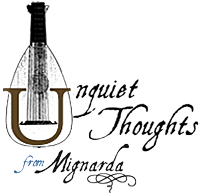Saturday morning quotes 4.50: Who played what?
We all have our own ideas and images that spring to mind when considering the sound picture of early music. For some, it’s the sound of recorders or other wind instruments played in consort. For others, it’s the costumes and the “Renaissance Fayre” modern mishmash of old tunes and not so old tunes played on instruments that go bang in the night. For many, it’s the sound of lute songs from the era of Shakespeare sung by a (bargain) countertenor. In terms of economics, for many, the renaissance was just a blip in time before the higher-profile baroque music revival demonstrated that elegance be damned, and instrumentalists must develop an attention-grabbing stance and singers working with a modern technique pull faces and belt or warble with impunity. These images all confirm Richard Taruskin’s premise that early music today is merely a modern re-creation based upon late 20th-century ideals and economics.
As usual, we find that the surviving sources paint a very different picture of both sound and presentation. This week’s post examines just what sort of instrumental music was performed in polite company in late 16th-century Italy, drawing upon a very interesting article by Timothy A. Collins, “Musica Secreta Strumentali: The Aesthetics and Practice of Private Solo Instrumental Performance in the Age of Monody (Ca. 1580 – Ca. 1610),” International Review of the Aesthetics and Sociology of Music, Vol. 35, No. 1 (Jun., 2004), pp. 47-62 (Published by the Croatian Musicological Society).
Collins first describes several accounts of virtuoso instrumentalists and singers who were highly regarded at the time in the realm of public music, but there is little evidence that they played loud instruments in small chambers among the noble amateurs, professional musicians, composers and theorists who were the Florentine Camerata. He quotes that Castiglione (1528)
…gave high regard to singing to the accompaniment of the lute because it is “most delightful and gives the words a wonderful charm and effectiveness.” But [Castiglione] cautions that it should only be done as a pastime…”[and] not in the presence of persons of low birth or where there is a crowd.”
Of course, this is not new information, but it helps to remind ourselves that the lute was never intended to be played before large audiences in capacious concert halls, which sadly encourages inauthentic instruments and playing techniques just so the thing can be heard. The public lute concert performed in large halls is a modernism that we must either accept or reject: Concertizing is the only way for a professional lutenist to sustain him or herself, but it is most inauthentic. The option of repeated performances for fewer people in smaller venues is a solution that strikes a balance between modern economics and original performance practice.
As for the dulcet sound of the recorder consort, Collins reports:
Wind instruments, on the other hand were wholly unsuitable for gentlemanly gatherings, presumably because of the impolite and unnatural contortions that were necessary to produce sounds on them, as well as their perceived offensive”nature” or “proportion.” Recorders, which were primarily consort instruments, are virtually never encountered in accounts of solo chamber music, though there is a modest number of iconographic examples that show its use in such settings and didactic material intended to develop virtuoso solo technique.
Again, we are focused on a particular era in late 16th-century Italy, the gentlemen being those of the Florentine Camerata. But evidence is evidence and we must acquaint ourselves with the facts before we choose what to ignore.
As for loud wind instruments, we turn to Vincenzo Galilei, quoted from Dialogo della musica antica et della moderna (Venice, 1581).
Cornetti and trombones were invented and introduced into musical concerts rather through the need for sopranos and basses, or let us say in order to provide more substance and noise in these [concerts], or else for both reasons, than because of some good, necessary effect which they make there. In order to prove that this is true, observe that these instruments are not ordinarily heard elsewhere except where it is necessary for such voices…They will indeed be heard many times in masquerades, in the theaters, upon the balconies of the public squares for the satisfaction of the plebians and the [common] people, and against every propriety in choruses and in organ lofts of sacred temples for the solemn feasts…Since the trombone possesses a sound quite similar to the bellowing of bulls…and since it is consequently formidable, it would be more appropriate in forests in order to chase the wild beasts from their homes and lairs…
Galilei then clearly explains the need for harmonic instruments – lutes and keyboards:
One could not or should not, for various reasons, compare such professors as these [wind players] to any of the reputed players of the lute and of keyboard instruments, first because of the great facility of the latter and the great difficulty of the former, and also because [wind instruments] play only one part…In addition, only one of these is not worth a thing in the world, since four to six are needed (according to the usage of today) for the perfection of the harmony, and since in tradition their professors are unable to speak, let alone discourse while they are playing them. In addition the one playing them can very easily remain…without knowledge and practice of counterpoint and theory…
While Collins’ article mentions several instrumental virtuosi who played wind and bowed instruments and created a fleeting appreciation among the susceptible, in the end, Galilei makes the point that prevails. Among the cognoscenti, the lute held and still holds pride of place as the more refined instrument capable of playing many parts as a solo instrument or in consort. Because its delicacy of sound causes the sensitive singer, the instrumental companion, or the listener with refined ears to focus, judiciously balance volume, and take notice of the detail, the lute’s intimacy is its greatest quality.

Ron, Loved to read this post!
LikeLike